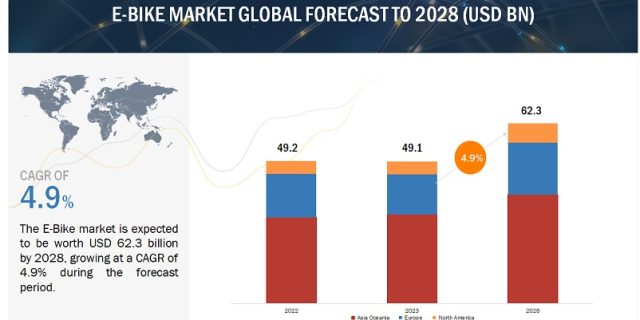
The global E-Bike market is projected to grow from USD 49.1 billion in 2023 to USD 62.3 billion by 2028 at a CAGR of 4.9%. The worldwide demand for e-bikes is growing rapidly as customers see e-bikes as an eco-friendly solution for commutes, with rising fuel prices adding to support the inclination. Government bodies in various cities worldwide have undertaken initiatives to build bicycle highway lanes for e-bikes.
The e-bike industry has declined in 2023 in some regions due to economic uncertainty, supply chain disruptions, and price competition due to intense competition. However, these are temporary challenges, and the market would remain positive in the long-term outlook. Though the e-bike market in other regions hasn’t shown any decline, the market has shown steady growth. Reasons such as growing environmental concerns, government support such as dedicated lanes or incentives, technological advancements, and changing consumer preferences would drive the market in the long run. Increasing inclination towards multi-modal transportation would also drive the market for e-bikes in the coming years.
Market Dynamics
DRIVER: Government support to increase e-bike sales to lower CO2 emissions
The electric bicycle (e-bike) is a low-emission mode of transportation that offers benefits in health, time, cost, safety, congestion, air & noise pollution, and energy security. Over short distances, e-bikes are a more efficient alternative to other means of transportation. E-bike riders save money and contribute to less environmental impact. However, producing e-bike components, such as batteries or drives, causes more emissions. In everyday life, the eBikes can be used instead of cars in many situations, such as shopping for a cargo bike. The energy requirement of an e-bike is around 11.2 Wh of electricity per mile traveled, which is very low. According to the Federal Environment Agency, a car emits about 240 g of CO2 per passenger mile, while public transportation emits between 80 and 176 g of CO2 per passenger mile. Bicycles and eBikes have significantly lower emissions than other modes of transportation.
Download PDF Brochure @ https://www.marketsandmarkets.com/pdfdownloadNew.asp?id=110827400
OPPORTUNITY: The trend toward connected e-bikes
Connected e-bikes are intelligent and omniscient bikes capable of communicating key data on their condition and use. In some cases, connected bikes can also receive information and commands remotely. Connected e-bike systems allow both data gathering and data mining. Companies are coming forward to develop connected solutions, like Specialized Bicycle Components Inc (US), which has acquired mission control and ride features in its product offerings. Shimano Inc (Japan) has developed an e-tube ride feature. Thus, apart from e-bikes, manufacturers focus on developing technologies and services to support customers in an advanced manner.
According to a United Nations report, ~70% of the world’s population will live in cities, resulting in more road traffic congestion by 2050. Megatrends such as urbanization, digitalization, and sustainability are emerging. Therefore, the trend for connected e-bikes would create an opportunity for the e-bike market to develop and grow during the forecasted period.
Lithium-ion is expected to be the most preferred battery chemistry in e-bikes during the forecast period.
The E-Bikes with lithium-ion batteries are estimated to account for the largest share of e-bikes due to the various benefits offered by these batteries, such as better lifecycle, high energy density, wide operating temperatures, and more power-to-weight ratio than other battery types. These batteries have also shown a sharp decline in prices in recent years. Lithium-ion battery prices have declined by almost 90% in the last few years. Increased competition in the market has put pressure on manufacturers to reduce costs to remain competitive. With the growth of the E-Bike industry, the lithium-ion battery market is expected to grow and explore this new technology. In 2019, the output of high-end products such as lithium-ion battery E-Bikes stood at nearly 5 million units, accounting for ~14% of total E-Bike output in China. The efforts of manufacturers to produce lightweight E-Bikes have also resulted in the higher adoption of lithium-ion batteries.
City/Urban bikes are expected to be the largest e-bike applications during the forecast period.
The city/urban e-bikes are primarily used for daily commutes in metro areas; these are low-step frame bicycles designed for gentle terrain and trips around cities and urban areas. The price range of city/urban e-bikes ranges between USD 1,500 and USD 5,000, depending on their features. China, Japan, India, and South Korea in Asia Oceania face traffic congestion due to high population and vehicle density. Government policies and rebates are driving the market of city/urban E-Bikes. Mountain/trekking and Cargo bikes are expected to show faster growth in coming years. Pedego (City commuter), Rad Power Bikes (Rad City 5 plus), and Vanmoof S3 are some top-selling city E-Bikes.
North American e-bike market by value is projected to grow during the forecast year 2023-2028
In North America, city E-Bikes are expected to grow at the highest CAGR due to the increased adoption of electric bikes for daily commuting, recreation, and fitness activities. Trekking and mountain biking are two off-road sports and recreational activity mediums gaining popularity in the region, which is why the demand for e-MTBs is increasing. Crossroad biking has also gained popularity due to the rising number of women and kids entering this sport. Several cyclist organizations, such as League of America Wheelman, IMBA, and Bike Centennial, have undertaken initiatives and projects to encourage more individuals to enter this sport. Thus, all these factors lead to an increase in the demand for mountain and trekking E-Bikes. To reduce emissions, governments in North America are offering incentives to purchase cargo E-Bikes. These factors would increase the demand for E-Bikes in North America during the forecast period.
Key Market Players
The key players in the E-Bike market are Accell Group NV (Netherlands), Giant Manufacturing Co., Ltd. (Taiwan), Yadea Group Holdings., Ltd. (China), Yamaha Motor Company (Japan), and Pedego (US). Major companies’ key strategies to maintain their position in the global market are strong global networking, mergers and acquisitions, partnerships, and technological advancement.
Request Free Sample Report @ https://www.marketsandmarkets.com/requestsampleNew.asp?id=110827400

